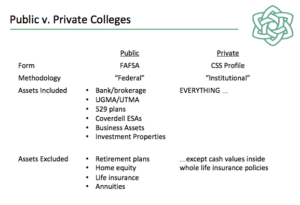
529 plans are a powerful tool for building college savings, yet many worry that 529’s are too restrictive – that the money they put in could be “lost” somehow if the child gets a sports or academic scholarship, or chooses not to go to college at all.
Fear not! You have options.
First, you can always withdraw the money that you contributed penalty- and tax-free. Second, if Junior earns a sports or academic scholarship, you can take money out of the 529 plan up to the dollar amount of the scholarship penalty-free.
There is a small catch. When you take a distribution from a 529, the IRS will consider a portion of that to come from “contributions” and another from growth or “earnings.” The latter part will be taxed as ordinary income. So how does the IRS figure out what portion comes from earnings v. contributions?
It’s just a simple ratio. Let’s say you’ve contributed $500 per month to Junior’s 529 from the time he was born and used one of those “age-based” investment options the plan offers. Initially, the account was invested 100% in stocks but over time it’s shifted to mostly bonds and CDs. By the time he’s 18, the account has grown to $177,207. Of that, $108,000 (or 61%) represents money contributed while $69,207 (or 39%) represents earnings in the account.
So, say Junior gets a scholarship worth $25k his Freshman year. If you take $25,000 from his 529, 39% of that – or $9,750 – will be considered earnings and be taxed as ordinary income. Had you invested in a traditional brokerage account, instead of Junior’s 529, would you have come out ahead? Multiple factors come into play. Were your gains in the traditional brokerage account short-term in nature and taxed as ordinary income? Given changes to the tax code over time and your own career trajectory, how have your personal tax rates changed? Using some pretty middle-of-the-road assumptions, my quick calculations show it to be a wash.
Another option is to leave the funds in the 529 plan and let them grow until your kids’ kids are old enough for college. You can always change the beneficiaries of a 529 account and there is no deadline by which you have to use the funds. This makes 529s a great vehicle for creating what amount to educational trust funds for future generations.
Given all of that, it doesn’t make sense not to use a 529 to save for college.







